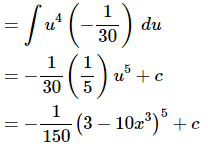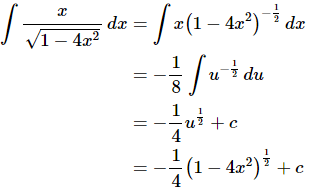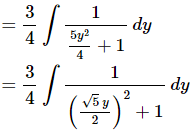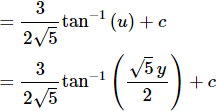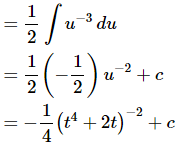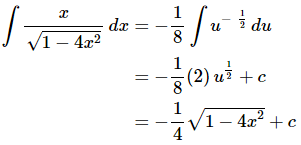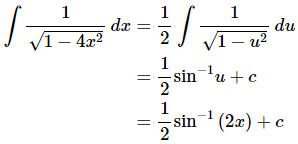Substitution Rule For Indefinite Integrals
After the last section we now know how to do the following integrals.

All of the integrals we’ve done to this point have required that we just had an x, or a t, or a w, etc. and not more complicated terms such as,

All of these look considerably more difficult than the first set. However, they aren’t too bad once you see how to do them. Let’s start with the first one.

In this case let’s notice that if we let

and we compute the differential (you remember how to compute these right?) for this we get,

Now, let’s go back to our integral and notice that we can eliminate every x that exists in the integral and write the integral completely in terms of u using both the definition of u and its differential.


In the process of doing this we’ve taken an integral that looked very difficult and with a quick substitution we were able to rewrite the integral into a very simple integral that we can do.Evaluating the integral gives,

As always, we can check our answer with a quick derivative if we’d like to and don’t forget to “back substitute” and get the integral back into terms of the original variable.What we’ve done in the work above is called the Substitution Rule. Here is the substitution rule in general.

A natural question at this stage is how to identify the correct substitution. Unfortunately, the answer is it depends on the integral. However, there is a general rule of thumb that will work for many of the integrals that we’re going to be running across.
When faced with an integral we’ll ask ourselves what we know how to integrate. With the integral above we can quickly recognize that we know how to integrate

However, we didn’t have just the root we also had stuff in front of the root and (more importantly in this case) stuff under the root. Since we can only integrate roots if there is just an xx under the root a good first guess for the substitution is then to make uu be the stuff under the root.
Another way to think of this is to ask yourself if you were to differentiate the integrand (we’re not of course, but just for a second pretend that we were) is there a chain rule and what is the inside function for the chain rule. If there is a chain rule (for a derivative) then there is a pretty good chance that the inside function will be the substitution that will allow us to do the integral.
We will have to be careful however. There are times when using this general rule can get us in trouble or overly complicate the problem. We’ll eventually see problems where there are more than one “inside function” and/or integrals that will look very similar and yet use completely different substitutions. The reality is that the only way to really learn how to do substitutions is to just work lots of problems and eventually you’ll start to get a feel for how these work and you’ll find it easier and easier to identify the proper substitutions.
Now, with that out of the way we should ask the following question. How, do we know if we got the correct substitution? Well, upon computing the differential and actually performing the substitution every x in the integral (including the x in the dx) must disappear in the substitution process and the only letters left should be u’s (including a du) and we should be left with an integral that we can do.
If there are x’s left over or we have an integral that cannot be evaluated then there is a pretty good chance that we chose the wrong substitution. Unfortunately, however there is at least one case (we’ll be seeing an example of this in the next section) where the correct substitution will actually leave some x’s and we’ll need to do a little more work to get it to work.
Again, it cannot be stressed enough at this point that the only way to really learn how to do substitutions is to just work lots of problems. There are lots of different kinds of problems and after working many problems you’ll start to get a real feel for these problems and after you work enough of them you’ll reach the point where you’ll be able to do simple substitutions in your head without having to actually write anything down.
As a final note we should point out that often (in fact in almost every case) the differential will not appear exactly in the integrand as it did in the example above and sometimes we’ll need to do some manipulation of the integrand and/or the differential to get all the xx’s to disappear in the substitution.
Let’s work some examples so we can get a better idea on how the substitution rule works.
Example 1: Problem Statement.

Ans. In this case it looks like we have a cosine with an inside function and so let’s use that as the substitution.

So, as with the first example we worked the stuff in front of the cosine appears exactly in the differential. The integral is then,


Don’t forget to go back to the original variable in the problem.

Ans. Again, it looks like we have an exponential function with an inside function (i.e. the exponent) and it looks like the substitution should be,

Now, with the exception of the 3 the stuff in front of the exponential appears exactly in the differential. Recall however that we can factor the 3 out of the integral and so it won’t cause any problems. The integral is then,



Ans. In this case it looks like the following should be the substitution.

Okay, now we have a small problem. We’ve got an x2 out in front of the parenthesis but we don’t have a “-30”. This is not really the problem it might appear to be at first. We will simply rewrite the differential as follows.

With this we can now substitute the x2dx away. In the process we will pick up a constant, but that isn’t a problem since it can always be factored out of the integral.We can now do the integral.


Note that in most problems when we pick up a constant as we did in this example we will generally factor it out of the integral in the same step that we substitute it in.
Ans. In this example don’t forget to bring the root up to the numerator and change it into fractional exponent form. Upon doing this we can see that the substitution is,

The integral is then,

In the previous set of examples the substitution was generally pretty clear. There was exactly one term that had an “inside function” and so there wasn’t really much in the way of options for the substitution. Let’s take a look at some more complicated problems to make sure we don’t come to expect all substitutions are like those in the previous set of examples.
Example 2: Problem Statement.

Ans. In this problem there are two “inside functions”. There is the 1−x that is inside the two trig functions and there is also the term that is raised to the 4th power.There are two ways to proceed with this problem. The first idea that many students have is substitute the 1−x away. There is nothing wrong with doing this but it doesn’t eliminate the problem of the term to the 4th power. That’s still there and if we used this idea we would then need to do a second substitution to deal with that.The second (and much easier) way of doing this problem is to just deal with the stuff raised to the 4th power and see what we get. The substitution in this case would be,

Two things to note here. First, don’t forget to correctly deal with the “-”. A common mistake at this point is to lose it. Secondly, notice that the 1−x turns out to not really be a problem after all. Because the 1−x was “buried” in the substitution that we actually used it was also taken care of at the same time. The integral is then,


As seen in this example sometimes there will seem to be two substitutions that will need to be done however, if one of them is buried inside of another substitution then we’ll only really need to do one. Recognizing this can save a lot of time in working some of these problems.

Ans. This one is a little tricky at first. We can see the correct substitution by recalling that,

Using this it looks like the correct substitution is,

Notice that we again had two apparent substitutions in this integral but again the 3z is buried in the substitution we’re using and so we didn’t need to worry about it.Here is the integral.


Note that the one third in front of the integral came about from the substitution on the differential and we just factored it out to the front of the integral. This is what we will usually do with these constants.

Ans. In this case we’ve got a 4tt, a secant squared as well as a term cubed. However, it looks like if we use the following substitution the first two issues are going to be taken care of for us.

The integral is now,


The most important thing to remember in substitution problems is that after the substitution all the original variables need to disappear from the integral. After the substitution the only variables that should be present in the integral should be the new variable from the substitution (usually uu). Note as well that this includes the variables in the differential!This next set of examples, while not particularly difficult, can cause trouble if we aren’t paying attention to what we’re doing.
Example 3: Problem Statement.

Ans. We haven’t seen a problem quite like this one yet. Let’s notice that if we take the denominator and differentiate it we get just a constant and the only thing that we have in the numerator is also a constant. This is a pretty good indication that we can use the denominator for our substitution so,

The integral is now,


Remember that we can just factor the 3 in the numerator out of the integral and that makes the integral a little clearer in this case.

Ans. The integral is very similar to the previous one with a couple of minor differences but notice that again if we differentiate the denominator we get something that is different from the numerator by only a multiplicative constant. Therefore, we’ll again take the denominator as our substitution.

The integral is,



Ans. Now, this one is almost identical to the previous part except we added a power onto the denominator. Notice however that if we ignore the power and differentiate what’s left we get the same thing as the previous example so we’ll use the same substitution here.

The integral in this case is,


Be careful in this case to not turn this into a logarithm. After working problems like the first two in this set a common error is to turn every rational expression into a logarithm. If there is a power on the whole denominator then there is a good chance that it isn’t a logarithm.
The idea that we used in the last three parts to determine the substitution is not a bad idea to remember. If we’ve got a rational expression try differentiating the denominator (ignoring any powers that are on the whole denominator) and if the result is the numerator or only differs from the numerator by a multiplicative constant then we can usually use that as our substitution.

Ans. Now, this part is completely different from the first three and yet seems similar to them as well. In this case if we differentiate the denominator we get a y that is not in the numerator and so we can’t use the denominator as our substitution.In fact, because we have y2 in the denominator and no y in the numerator is an indication of how to work this problem. This integral is going to be an inverse tangent when we are done. The key to seeing this is to recall the following formula,

We clearly don’t have exactly this but we do have something that is similar. The denominator has a squared term plus a constant and the numerator is just a constant. So, with a little work and the proper substitution we should be able to get our integral into a form that will allow us to use this formula.
There is one part of this formula that is really important and that is the “1+” in the denominator. The “1+” must be there and we’ve got a “4+” but it is easy enough to take care of that. We’ll just factor a 4 out of the denominator and at the same time we’ll factor the 3 in the numerator out of the integral as well. Doing this gives,


Notice that in the last step we rewrote things a little in the denominator. This will help us to see what the substitution needs to be. In order to get this integral into the formula above we need to end up with a u2 in the denominator. Our substitution will then need to be something that upon squaring gives us 5y2/4. With the rewrite we can see what that we’ll need to use the following substitution.

Don’t get excited about the root in the substitution, these will show up on occasion. Upon plugging our substitution in we get,

After doing the substitution, and factoring any constants out, we get exactly the integral that gives an inverse tangent and so we know that we did the correct substitution for this integral. The integral is then,


In this last set of integrals we had four integrals that were similar to each other in many ways and yet all either yielded different answer using the same substitution or used a completely different substitution than one that was similar to it.
This is a fairly common occurrence and so you will need to be able to deal with these kinds of issues. There are many integrals that on the surface look very similar and yet will use a completely different substitution or will yield a completely different answer when using the same substitution.
Let’s take a look at another set of examples to give us more practice in recognizing these kinds of issues. Note however that we won’t be putting as much detail into these as we did with the previous examples.
Example 4: Problem Statement.

Ans: Clearly the derivative of the denominator, ignoring the exponent, differs from the numerator only by a multiplicative constant and so the substitution is,

After a little manipulation of the differential we get the following integral.


Ans. The only difference between this problem and the previous one is the denominator. In the previous problem the whole denominator is cubed and in this problem the denominator has no power on it. The same substitution will work in this problem but because we no longer have the power the problem will be different. So, using the substitution from the previous example the integral is,


So, in this case we get a logarithm from the integral.

Ans. Here, if we ignore the root we can again see that the derivative of the stuff under the radical differs from the numerator by only a multiplicative constant and so we’ll use that as the substitution.

The integral is then,


Ans. In this case we are missing the x in the numerator and so the substitution from the last part will do us no good here. This integral is another inverse trig function integral that is similar to the last part of the previous set of problems. In this case we need to following formula.

The integral in this problem is nearly this. The only difference is the presence of the coefficient of 4 on the x2. With the correct substitution this can be dealt with however. To see what this substitution should be let’s rewrite the integral a little. We need to figure out what we squared to get 4x2 and that will be our substitution.
With this rewrite it looks like we can use the following substitution.
The integral is then,

Since this document is also being presented on the web we’re going to put the rest of the substitution rule examples in the next section. With all the examples in one section the section was becoming too large for web presentation.






















